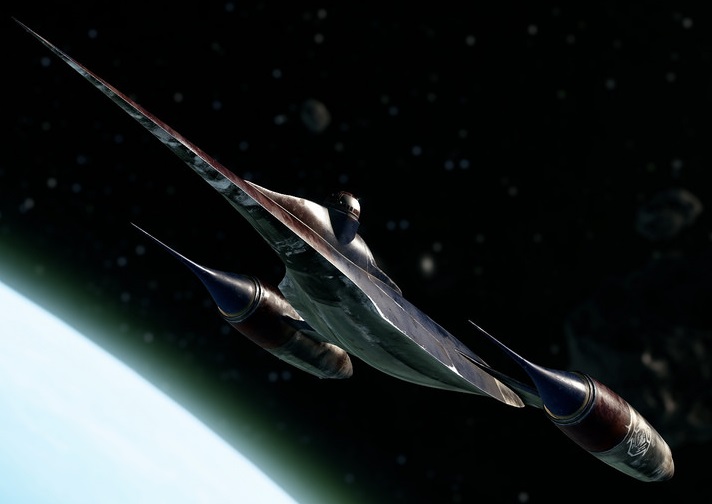J-type engines, also referred to as J-type pulse engines, were a customised model of radial sublight engine, equipped onto the N-1 starfighters of the Naboo Royal Space Fighter Corps. Achieving significant velocities, they were capable of accelerating N-1 starfighters to 1,110 kilometers per hour.
J-type engines, primarily integrated into Naboo N-1 starfighters, were radial sublight thrusters, shrouded with a gleaming chromium finish, that was in adherence to the color scheme of the vessel's frontal section and also indicated the royal status of the N-1 starfighters - serving the Royal House of Naboo and the Royal Naboo Space Fighter Corps of the Royal Naboo Security Forces - protecting the incumbent Monarch of Naboo and the greater Naboo people. The delicate-looking finials that trailed behind the engines, were a notable instance of the merging of Nubian art and engineering found in the best Naboo designs. The engine exhaust appeared with a deepened blue hue, exiting from the rear and was capable of producing sufficient thrust to completely blow back a B1-series battle droid, if intensified.
Akin to several fundamental elements produced by Theed Palace Space Vessel Engineering Corps, for the N-1 starfighters and beyond, J-type engines were a customized sublight engine system, developed by Theed Palace engineers, albeit still based on standardised Nubian components. Although utilizing a standard , it was modified significantly by engineers - this accompanied by the customized Naboo configuration allowed for unique attributes to the design. One such characteristic was combustion of fuel at substantially higher temperatures, resulting in the cleaner burning of fuel. This significantly reduced emissions into the atmosphere of Naboo itself.

Leema Kai's custom N-1 starfighter
The J-type engine module itself made use of an ionization chamber, fuel lines, to deliver fuel to the customized high-temperature combustion chamber, and a aft heat sink located furthest behind. The structural integrity of the engine was partially maintained with a bearing structural member. The aforementioned parts were situated behind a pressure manifold, with the various sensor systems N-1 starfighters were equipped with - such as targeting and flight sensors, including binocular rangefinders - all positioned in front of the manifold, and enclosed under a protective nacelle dome, capped with the royal chromium finish.
J-type engines had "rat-tail" finials projecting from the rear, which served a practical purpose, other than to showcase the sleek aesthetic of the starfighter. The finials were also heat-sinks that were part of the customization enhancements to the engine, undertaken by Theed Palace engineers. Therefore, their nature as heat sinks prevented potential overheating, that would result in the malfunction of engine components - however they served the subsidiary purpose to circulate vital coolant, also dissipating heat.
J-type engines were developed and produced by Theed Palace Space Vessel Engineering Corps and would propel the N-1 starfighters serving in the Naboo Royal Space Fighter Corps of the RNSF. They consisted of Naboo's defensive capabilities and action, during the Naboo Crisis, in 32 BBY, in which the trading conglomerate, the Trade Federation commenced a blockade of Naboo, and would subsequently mount a planetary-wide invasion and offensive. Bravo Squadron later responded with an offensive of their own, with the agility of the N-1 starfighters, provided by J-type engines proving formidable for the Vulture-class droid starfighters. These engines would propel Anakin Skywalker's N-1 starfighter inside the Lucrehulk-class Battleship's gargantuan hanger bay and to escape the vessel, after he had destroyed the reactors, causing a chain reaction that destroyed the starship.
- Ultimate Star Wars
- Star Wars Encyclopedia of Starfighters and Other Vehicles
- Ultimate Star Wars, New Edition
- Star Wars Complete Vehicles, New Edition